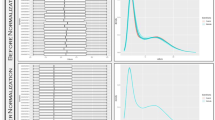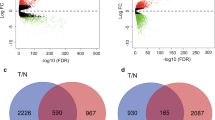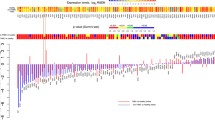Abstract
Breast cancer is a complex and heterogenous disease. Classical molecular medical approaches cannot fully understand and comprehend its pathogenesis. In this review, the development of new biological markers for the early detection and creation of guided and specific therapy of breast cancer are discussed in light of the rapid advances in the “omics”. Results of cancer research in combination with large-scale methods that examine the expression status of genes and proteins have identified a large number of new biomarkers as well as confirmed the human growth hormone as an important player in the pathogenesis of this disease through its autocrine regulation where it influences the activation of Pax5 and HOXA1 gene networks.



Similar content being viewed by others
References
Bagnato A, Rosano L (2008) The endothelin axis in cancer. Int J Biochem Cell Biol 40(8):1443–1451
Becker S, Cazares LH, Watson P, Lynch H, Semmes OJ, Drake RR, Laronga C (2004) Surfaced-enhanced laser desorption/ionization time-of-flight (SELDI-TOF) differentiation of serum protein profiles of BRCA-1 and sporadic breast cancer. Ann Surg Oncol 11(10):907–914
Bertucci F, Birnbaum D, Goncalves A (2006) Proteomics of breast cancer: principles and potential clinical applications. Mol Cell Proteomics 5(10):1772–1786
Biscardi JS, Ishizawar RC, Silva CM, Parsons SJ (2000) Tyrosine kinase signaling in breast cancer: epidermal growth factor receptor and c-Src interactions in breast cancer. Breast Cancer Res 2(3):203–210
Børresen AL, Andersen TI, Eyfjörd JE, Cornelis RS, Thorlacius S, Borg A, Johansson U, Theillet C, Scherneck S, Hartman S et al (1995) TP53 mutations and breast cancer prognosis: particularly poor survival rates for cases with mutations in the zinc-binding domains. Genes Chromosomes Cancer 14(1):71–75
Busslinger M, Klix N, Pfeffer P, Graninger PG, Kozmik Z (1996) Deregulation of PAX-5 by translocation of the Eµ enhancer of the IgH locus adjacent to two alternative PAX-5 promoters in a diffuse large cell lymphoma. Proc Natl Acad Sci 99:6129–6134
Ceakite L, Haug O, Myklebost O, Aldrin M, Ostenstad B, Holden M, Frigessi A, Hovig E, Sioud M (2004) Analysis of humoral immune response to immunoselected phage-displayed peptides by a microarray-based method. Proteomics 4(9):2572–2582
Champine PJ, Michaelson J, Weimer BC, Welch DR, DeWald DB (2007) Microarray analysis reveals potential mechanisms of BRMS1-mediated metastasis suppression. Clin Exp Metastasis 24(7):551–565
Cicek M, Samant RS, Kinter M, Welch DR, Casey G (2004) Identification of metastasis-associated proteins through protein analysis of metastatic MDA-MB 435 and metastasis-suppressed BRMS1 transfected-MDA-MB-435 cells. Clin Exp Metastasis 21(2):149–157
Fontana S, De Leo G, Sedic M, Kraljevic Pavelic S, Alessandro R (2006) Proteomics in antitumor research. DDT: technologies 3:441–449
Gebre-Medhin M, Kindblom LG, Wennbo H, Törnell J, Meis-Kindblom JM (2001) Growth hormone receptor is expressed in human breast cancer. Am J Pathol 158(4):1217–1222
Gong Y, Yan K, Lin F, Anderson K, Sotiriou C, Andre F, Holmes FA, Valero V, Booser D, Pippen JE Jr, Vukelja S, Gomez H, Mejia J, Barajas LJ, Hess KR, Sneige N, Hortobagyi GN, Pusztai L, Symmans WF (2007) Determination of oestrogen-receptor status and ERBB2 status of breast carcinoma: a gene-expression profiling study. Lancet Oncol 8(3):203–211
Hathout Y, Gehrmann ML, Chertov A, Fenselau C (2004) Proteomic phenotyping: metastatic and invasive breast cancer. Cancer Lett 210(2):245–253
Ho J, Kong JW, Choong LY, Loh MC, Toy W, Chong PK, Wong CH, Wong CY, Shah N, Lim YP (2009) Novel breast cancer metastasis-associated proteins. J Proteome Res 8(2):583–594
Holmes ML, Pridans C, Nutt SL (2008) The regulation of the B-cell gene expression programme by Pax5. Immunol Cell Biol 86(1):47–53
Hudelist G, Singer CF, Kubista E, Czerwenka K (2005) Use of high-throughput arrays for profiling differentially expressed proteins in normal and malignant tissues. Anticancer Drugs 16(7):683–689
Jessani N, Niessen S, Wei BQ, Nicolau M, Humphrey M, Ji Y, Han W, Noh DY, Yates JR 3rd, Jefery SS, Cravatt BF (2005) A streamlined plaarform for high-content functional proteomics of primary human specimens. Nat Methods 2(9):691–697
Jonkers J, Moolenaar WH (2009) Mammary tumorigenesis through LPA receptor signaling. Cancer Cell 15(6):457–459
Jung EJ, Moon HG, Cho BI, Jeong CY, Joo YT, Lee YJ, Hong SC, Choi SK, Ha WS, Kim JW, Lee CW, Lee JS, Park ST (2007) Galectin-1 expression in cancer-associated stromal cells correlates tumor invasiveness and tumor progression in breast cancer. Int J Cancer 120(11):2331–2338
Kairouz R, Daly RJ (2000) Tyrosine kinase signalling in breast cancer: modulation of tyrosine kinase signalling in human breast cancer through altered expression of signalling intermediates. Breast Cancer Res 2(3):197–202
Kim DH, Bae J, Lee JW, Kim SY, Kim YH, Bae JY, Yi JK, Yu MH, Noh DY, Lee C (2009) Proteomic analysis of breast cancer tissue reveals up regulation of actin remodeling proteins and its relevance to cancer invasiveness. Proteomics Clin 3(1):30–40
Kreunin P, Urquidi V, Lubman DM, Goodison S (2004) Identification of metastasis-associated proteins in a human tumor metastasis model using the mass-mapping technique. Proteomics 4(9):2754–2765
Lane PD (1992) Cancer. p53 guardian of the genome. Nature 358:15–16
Mohankumar KM, Xu XQ, Zhu T, Kannan N, Miller LD, Liu ET, Gluckman PD, Sukumar S, Emerald BS, Lobie PE (2007) HOXA1-stimulated oncogenicity is mediated by selective upregulation of components of the p44/42 MAP kinase pathway in human mammary carcinoma cells. Oncogene 26(27):3998–4008
Nielsen UB, Cardone MH, Sinskey AJ, MacBeath G, Sorger PK (2003) Profiling receptor tyrosine kinase activation by using Ab microarrays. Proc Natl Acad Sci U S A 100(16):9330–9335
Nimeus E, Malmstrom J, Johnsson A, Marko-Varga G, Ferno M (2006) Proteomic analysis identifies candidate proteins associated with distant recurrences in breast cancer after adjuvant chemotherapy. J Pharm Biomed Anal 43(3):1089–1093
Pawlik TM, Hawke DH, Liu Y, Krishnamurthy S, Fritsche H, Hunt KK, Kuerer HM (2005) Proteomic analysis of nipple aspirate fluid from women with early-stage breast cancer using isotope-coded affinity tags and tandem mass spectrometry reveals differential expression of vitamin D binding protein. BMC Cancer 6:68
Powell B, Soong R, Iacopetta B, Seshadri R, Smith DR (2000) Prognostic significance of mutations to different structural and functional regions of the p53 gene in breast cancer. Clin Cancer Res 6(2):443–451
Robson EJD, He SJ, Eccles MR (2006) A Panorama of PAX genes in cancer and development. Nat Rev Cancer 6(1):52–62
Saitoh S, Cunningham J, De Vries EM, McGovern RM, Schroeder JJ, Hartmann A, Blaszyk H, Wold LE, Schaid D, Sommer SS et al (1994) p53 gene mutations in breast cancers in midwestern US women: null as well as missense-type mutations are associated with poor prognosis. Oncogene 9(10):2869–2875
Sun B, Zhang S, Zhang D, Li Y, Zhao X, Luo Y, Guo Y (2008) Identification of metastasis-related proteins and their clinical relevance to triple-negative human breast cancer. Clin Cancer Res 14(21):7050–7059
Tennis M, Krishnan S, Bonner M, Ambrosone CB, Vena JE, Moysich K, Swede H, McCann S, Hall P, Shields PG, Freudenheim JL (2006) p53 Mutation analysis in breast tumors by a DNA microarray method. Cancer Epidemiol Biomarkers Prev 15(1):80–85
von Mering C, Jensen LJ, Kuhn M, Chaffron S, Doerks T, Krüger B, Snel B, Bork P (2007) STRING 7—recent developments in the integration and prediction of protein interactions. Nucleic Acids Res 35(Database issue):D358–D362
Vouyovitch CM, Vidal L, Borges S, Raccurt M, Arnould C, Chiesa J, Lobie PE, Lachuer J, Mertani HC (2008) Proteomic analysis of autocrine/paracrine effects of human growth hormone in human mammary carcinoma cells. Adv Exp Med Biol 617:493–500
Waters MJ, Conway-Campbell BL (2004) The oncogenic potential of autocrine human growth hormone in breast cancer. PNAS 101(42):14992–14993
Yang SX, Simon RM, Tan AR, Nguyen D, Swain SM (2005) Gene expression patterns and profile changes pre- and post-erlotinib treatment in patients with metastatic breast cancer. Clin Cancer Res 11(17):6226–6232
Yang F, Foekens JA, Yu J, Sieuwerts AM, Timmermans M, Klijn JG, Atkins D, Wang Y, Jiang Y (2006) Laser microdissection and microarray analysis of breast tumors reveal ER-alpha related genes and pathways. Oncogene 25(9):1413–1419
Zhang D, Tai LK, Wong LL, Chiu LL, Sethi SK, Koay ES (2005) Proteomic study reveals that proteins involved in metabolic and detoxification pathways are highly expressed in HER-2/neu-positive breast cancer. Mol Cell Proteomics 4(11):1686–1696
Zhu T, Starling-Emerald B, Zhang X, Lee KO, Gluckman PD, Hichem C, Mertani HC, Lobie PE (2005) Oncogenic transformation of human mammary epithelial cells by autocrine human growth hormone. Cancer res 65(1):317–324
Acknowledgments
We greatly appreciate the financial help of the Foundation of Croatian Academy of Sciences and Arts. This manuscript was also supported by the project of Ministry of Science Education and Sports 098-0982464-2393.
This work has been approved by an ethical committee of Clinical hospital “Sisters of Mercy” and all subjects gave informed consent.
Conflict of interest
The authors declare that they have no competing interests.
Author information
Authors and Affiliations
Corresponding author
Additional information
An erratum to this article can be found at http://dx.doi.org/10.1007/s10142-010-0194-z
Electronic supplementary material
Below is the link to the electronic supplementary material.
Supplementary material
The immunohystochemical results showing the presence of hGH and RGH in epithelial and stromal compound of ductal invasive carcinoma and breast fibroadenoma. 0 absent, 1 weak reaction, 2 moderate reaction, 3 strong reaction (DOC 71 kb)
Rights and permissions
About this article
Cite this article
Ratkaj, I., Stajduhar, E., Vucinic, S. et al. Integrated gene networks in breast cancer development. Funct Integr Genomics 10, 11–19 (2010). https://doi.org/10.1007/s10142-010-0159-2
Received:
Revised:
Accepted:
Published:
Issue Date:
DOI: https://doi.org/10.1007/s10142-010-0159-2




